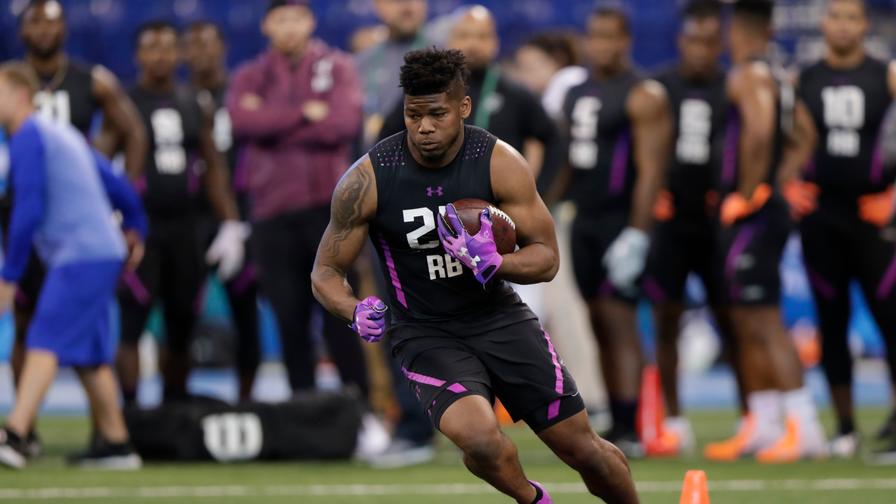Don't Let Seattle's Offensive Line Scare You Away From Rashaad Penny in Fantasy Football

Is the Seattle Seahawks offensive line good? In a word: no.
But are Seattle's woes up front something that will keep Rashaad Penny from being a successful fantasy running back in 2018?
Let's take a look.
The Duane Brown and Russell Wilson Effects
While no one is saying Seattle has a great offensive line -- our Jim Sannes ranked the unit 26th in his comprehensive offensive-line breakdown -- the Hawks' line may not be as bad you think. As Sannes noted in said piece, Seattle's offensive line performed better after the midseason acquisition of left tackle Duane Brown from the Houston Texans. This effect was notable in terms of both sack rate and the ground game.
Rushing Success Rate is defined as any run that results in positive Net Expected Points (NEP). You can read more about NEP in our glossary.
| Past Two Seasons | Sack Rate | RB Success Rate | RB Success Rate to Left |
|---|---|---|---|
| Seahawks/Texans With Brown | 7.0% | 36.3% | 39.7% |
| Seahawks/Texans Without Brown | 7.2% | 34.5% | 36.8% |
This boost to Rushing Success Rate was more pronounced when running to the left, where Brown plays. And we shouldn't sleep on the slight boost in sack rate since the better an offense is, the more plays there will be for fantasy.
On top of the lift from Brown, the Seahawks also brought in guard D.J. Fluker this off-season. He's not good as pass blocker, but Fluker graded out as Pro Football Focus' 22nd-best run-blocker at the guard position in 2017.
It is also vital to consider the effect of a running quarterback like Russell Wilson. Running backs playing with dual-threat quarterbacks tend to have a positive correlation in Rushing NEP and Rushing Success Rate.
Considering that only Cam Newton and Michael Vick have rushed for more yards among quarterbacks through their age-29 seasons, Wilson certainly qualifies as a dual-threat quarterback.
Volume, Volume, Volume
The offensive line Penny has in front of him certainly matters, but opportunity is king in fantasy. Penny checks this box in a big way.
Excluding David Wilson, whose career was cut short due to injuries, rookie running backs taken in the first round since 2011 have averaged 19.75 combined carries and targets per game in their first season. Over a full 16-game season, this extrapolates out to 316 total opportunities.
Considering we have seen Pete Carroll feed a workhorse in the past with Marshawn Lynch and that new offensive coordinator Brian Schottenheimer is notorious for his run-heavy approach, this sure looks like a pretty dope landing spot for Penny.
To put it another way nearly half of the top 24 RBs since 200 have had a below average O-line, and an O-line ranked in the bottom 7 is more likely to produce a top 24 RB then a Rushing Share under 40% pic.twitter.com/2V5zLJaUca
— Peter Howard (@pahowdy) May 6, 2018
We can also expect more rushing scores for running backs in Seattle after Wilson accounted for all but one of the Seahawks' touchdowns last year. Of the 25 teams to score at least 80% of their touchdowns through the air in a single season, the average team rushed for 5.2 more rushing scores the following season, per Rich Hribar of Rotoworld.
Volume and touchdown opportunity should not be a problem for Penny.
Conclusion
Josh Norris of Rotoworld likes to say that, "NFL franchises are honest in two ways: with their wallets and with their draft picks."
The Seahawks spent their only pick in the top 75 of the 2018 NFL Draft on Penny. That counts for a lot, and it should make us feel good about Penny's chances to see big-time volume right away.
Plus, Seattle's offensive line isn't as putrid as one may think thanks to the additions of Brown and Fluker, and Wilson's running threat is the perfect deodorant to mask the bad smell of any offensive-line concerns.
All in all, with Penny going as the RB20 in standard formats, per Fantasy Football Calculator, he could be a smashing value this year and one of the best fantasy backs outside of the elite tier.
















